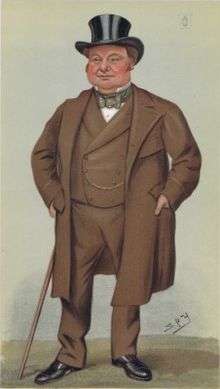Apedale Hall
Apedale Hall was a manor house near Newcastle-under-Lyme in Staffordshire, it was rebuilt in 1826 by the Heathcote family in the Elizabethan style by British Industrialist Richard Edensor Heathcote, (1780 - Genoa, Italy, 1850), but was demolished in 1934, due to subsidence from the coal mines underneath.

Sir Oswald Mosley, 4th Baronet, of Ancoats, 1848 - 1915, a.k.a. John Bull in an 1898 drawing/caricature, one of 1325, published in Vanity Fair by Sir Leslie Ward, (1851 - 1922)
Oswald Mosley, a.k.a. Sir Oswald Ernald Mosley, 6th Baronet, of Ancoats, (1896–1980), British politician, known principally as the founder of the British Union of Fascists lived there for a time in the early 20th century with his divorced mother, Katharine Maud Edwards-Heathcote, (1874–1950), and his paternal grandfather Sir Oswald Mosley, 4th Baronet, of Ancoats, (1848–1915), before its demolition.[1][2][3][4][5][6]
References
- "Introduction: Apedale Hall, Newcastle". Staffordshire Past Track. Archived from the original on 2012-08-19. Retrieved 2012-12-13.
- "Garden party at Apedale Hall, Newcastle" Archived August 19, 2012, at the Wayback Machine. Staffordshire Past Track. Retrieved 2012-12-13.
- "Turbulent Squire of Apedale - Richard Edensor Heathcote (1780-1850)" Archived September 28, 2011, at the Wayback Machine. David Dyble, MA. Acumenbooks.co.uk. Retrieved 2012-12-13.
- "Apedale Hall 1 2 3 Coal Mine Information and Photographs". Aditnow.co.uk. Retrieved 2012-12-13.
- Fionn Taylor (2006-10-04). "White Barn Colliery". Healeyhero.co.uk. Retrieved 2012-12-13.
- "Alsagers Bank". The Staffordshire Village Book, by members of the Staffordshire Federation of Women's Institutes and published by Countryside Books. Visitoruk.com. 1918-01-12. Retrieved 2012-12-13.
Further reading
- The House of Mitford by Jonathan Guinness, 3rd Baron Moyne, born 1930, with Catherine Guinness. Hutchinson, 1984. ISBN 0-09-155560-4
- Hitler and Churchill: Secrets of Leadership (2003), by controverted Conservative historian and visual media protagonist Andrew Roberts, born 1963. Weidenfeld and Nicolson, edts. London. 225 pages, ISBN 0-297-84330-3.
This article is issued from Wikipedia. The text is licensed under Creative Commons - Attribution - Sharealike. Additional terms may apply for the media files.